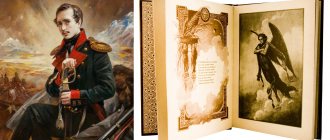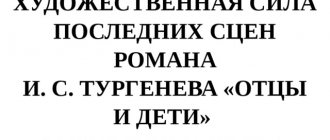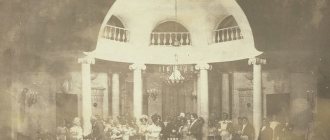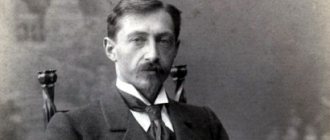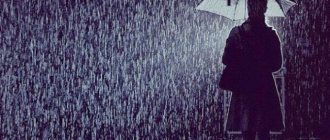4.1
Average rating: 4.1
Total ratings received: 87.
4.1
Average rating: 4.1
Total ratings received: 87.
“Leaves” is an example of F. I. Tyutchev’s early work. In this work, the author intertwined fairy-tale, landscape and philosophical motifs. A forest is depicted here, a parallel is drawn between processes in nature and human life. They study poetry in 6th grade. We suggest making your preparation for the lesson easier by using a brief analysis of “Leaves” according to the plan.
The material was prepared jointly with a teacher of the highest category, Kuchmina Nadezhda Vladimirovna.
Experience as a teacher of Russian language and literature - 27 years.
Brief Analysis
Before reading this analysis, we recommend that you familiarize yourself with the poem Leaves.
History of creation - the work was written in 1830, when the poet was serving in Germany. “Leaves” was first published in 1879 in the Russian Archive magazine.
The theme of the poem is the theme of freedom, the contrast of cold calm with rebellious nature.
Composition – The poem is written in the form of a monologue of leaves. In its meaning, several parts can be distinguished: reflections of the leaves on the needles, comparison of the “skinny greenery” with its beauty and the decision to fly away with the wind. The work consists of four octaves.
Genre : lyric poem.
The meter of the verse is two-foot amphibrachium, the rhyme pattern is cross ABAB.
Metaphors - “pine trees and spruces... wrapped in snow and blizzards, they sleep,” “we are an easy tribe,” “we visit on the branches for a short time,” “the marshmallows have left.”
Epithets – “skinny greenery”, “red summer”, “bothersome branches”, “violent winds”.
Comparisons - “green, like hedgehog needles.”
Lyrical reflections of leaves
The poet Tyutchev in his lyrics gravitated towards the literary direction of romanticism. Formed in writing activity in the middle of the 19th century. “Leaves” is an early work that was created when Fyodor Ivanovich was only 17 years old.
Composition of the work
History of creation: the poem was written in 1830, at that time the writer was in the diplomatic service abroad in Germany. Leaves were published for the general reader only in 1879. The main theme of the work is the reasoning of tree leaves about their own “existence”; a conflict of a rebellious and rebellious nature with icy calm.
Composition of the poem: composed in the form of a monologue of leaves. Some parts to note:
- Thoughts about pine needles.
- The juxtaposition of the “skinny green” with the beautiful and the desire to follow the wind.
The genre of literary work is elegy, because when depicting nature, philosophical questions are raised. Written in poetic meter, a two-foot amphibrach. With the help of expressive means, beautiful landscapes are reproduced, the feelings and experiences of the main characters in the work are described.
Metaphors in the work:
- the marshmallows are gone;
- We are an easy tribe;
- “pine and spruce trees, wrapped in snow and blizzards, are sleeping”;
- We are visiting on the branches.
In Russian literature, Tyutchev’s poem “Leaves” is an example of philosophical and landscape poetry. Nature often inspires a spiritual search for the meaning of life. In order to fully show the reader nature, the writer used the technique of personification; the leaves in the work of art are endowed with human traits. The lyrical hero largely merges with the leaves, because he fully supports their aspirations.
Tyutchev's epithets:
- summer is red;
- the winds are violent;
- skinny greens.
Comparison in a poetic work: greens are hedgehog needles.
The plot of the poem
When analyzing the first part at the beginning of the verse, the leaves share their thoughts that they are more attractive and better than pine needles. Fir trees and pines, it seems to them, have “skinny greenery” that will never be alive. The leaves wonder how it is possible to sleep all winter long, dressed in snowstorms. The leaves call themselves the “light tribe” and publicly admire themselves: “they bloom, they shine.” They indulge in bright memories of bathing in the sunshine and cool dew in the summer.
The wonderful mood of the green brethren gradually subsides. She begins to understand that autumn is ahead. The leaves look around and notice that the plants have had time to bloom, the birds begin to sing their trills less and less. The leaves refuse to turn yellow, the “light tribe” decides to fly with the wind when it is possible.
They are similar to human thoughts and aspirations. The poem represents human nature with its desire to never grow old. The author notes the attraction to new pleasant events, to freedom. Conifer needles are a symbol of the opposite human character, a brief drawing of a different perception. The main idea is contained in the statement: “so why should we hang and turn yellow for nothing?”
In the second part of the poem there is a certain sadness, although one feels excitement about the expected journey with the wind. Dedicated to comparing the essence of nature and the essence of man. Tyutchev, although still very young, feels like a very old man, for this reason he writes that he and his peers represent a kind of tribe whose existence is short-lived and fleeting. People, just like the leaves of trees, rejoice in the light and warmth of the sun, gusts of wind, and morning dew.
“The birds have died”, “the flowers have faded” - the Russian lyricist speaks about the short duration of youth, where sometimes mature age brings only disappointment, and old age comes with illnesses and an understanding of worthlessness. As the author believes, frailty and old age cannot be overcome, and the life of an elderly person is devoid of attractiveness and any meaning.
History of creation
The analysis of the poem should begin with the history of its writing. In 1821, Fyodor Ivanovich went to serve in Germany. Being a diplomat, the poet did not forget about his talent for poetic art. Philosophical motives play an important role in his “Munich” works. Apparently, this is due to the fact that in Germany the poet met the philosopher Schelling, who defended the idea of the unity of opposites in nature. After 9 years of living abroad, Tyutchev created “Leaves” (1830), which reflected the idea of the German philosopher.
In 1879, the poem was published on the pages of the Russian Conversation magazine. To this day, it is considered one of the best examples of landscape and philosophical lyrics in Russian literature.
Subject
Nature repeatedly inspired Tyutchev on philosophical quests. In the analyzed poem, the author developed two themes at once: the theme of freedom and the contrast of cold calm with rebellious nature. To reveal the soul of nature, the poet used personification, humanizing the leaves. The lyrical hero of the work practically does not show himself; he merges with the image of the leaves, because he completely shares their views.
In the first two stanzas of the poem, the leaves say that they consider themselves more beautiful than the pine needles. The “skinny green” of fir trees, in their opinion, never looks alive. The leaves cannot understand how you can sleep through the entire winter, wrapped up in a snowstorm. The “light tribe” openly admires itself: “we... bloom and shine.” The leaves remember how in summer they played with the sun and bathed in dew.
The cheerful mood of the green company fades when it realizes that autumn is on the doorstep. The leaves look around and see that everything around has faded, turned pale, and the birds have fallen silent. The “easy tribe” does not want to turn yellow, so they decide to fly away with the wind. Now the branches seem “bothering” to the leaves, so they try to fly away as quickly as possible.
In the image of leaves you can see human nature. They symbolize people who cannot sit in one place while waiting for old age. Such people strive for new achievements and freedom. The needles of the fir trees symbolize the opposite human character.
The main idea is figuratively expressed in the lines: “so why should we hang and turn yellow for nothing?”
Poem by F. I. Tyutchev “Leaves” - analysis according to plan
Option 1
History of creation
The analysis of the poem should begin with the history of its writing. In 1821, Fyodor Ivanovich went to serve in Germany. Being a diplomat, the man did not forget about his talent for poetic art. Philosophical motives play an important role in his “Munich” works. Apparently, this is due to the fact that in Germany the poet met the philosopher Schelling, who defended the idea of the unity of opposites in nature. After 9 years of living abroad, Tyutchev created “Leaves” (1830), which reflected the idea of the German philosopher.
In 1879, the poem was published on the pages of the Russian Conversation magazine. To this day, it is considered one of the best examples of landscape and philosophical lyrics in Russian literature.
Subject
Nature repeatedly inspired Tyutchev on philosophical quests. In the analyzed poem, the author developed two themes at once: the leaves’ reflections on their “life”; contrasting cold calm with rebellious nature. To reveal the soul of nature, the poet used personification, humanizing the leaves. The lyrical hero of the work practically does not show himself; he merges with the image of the leaves, because he completely shares their views.
In the first two stanzas of the poem, the leaves admit that they consider themselves more beautiful than the pine needles. The “skinny green” of fir trees, in their opinion, never looks alive. The leaves cannot understand how you can sleep through the entire winter, wrapped up in a snowstorm. The “light tribe” openly admires itself: “we... bloom and shine.” The leaves remember how in the summer they played with the sun and bathed in dew.
The cheerful mood of the green company fades when it realizes that autumn is just around the corner. The leaves are examined around and they see that everything around has faded, turned pale, and the birds have fallen silent. The “easy tribe” does not want to turn yellow, so they decide to fly away with the wind. Now the branches seem “bothering” to the leaves, so they try to fly away as quickly as possible.
In the image of leaves you can see human nature. They symbolize people who cannot sit in one place while waiting for old age. Such people strive for new achievements and freedom. The needles of the fir trees symbolize the opposite human character.
The main idea is figuratively expressed in the lines: “so why should we hang and turn yellow for nothing?”
Composition
The poem is written in the form of a leaf monologue. In its meaning, two parts can be distinguished: the leaves’ reflections on the needles, the comparison of “skinny greenery” with its beauty, and the decision to fly away with the wind. Formally, the work consists of four octaves (octaves).
Genre
The genre of the poem is elegy, as it develops a philosophical theme through the landscape. In the poems of the second part, a sad mood is felt, although the leaves are inspired by the upcoming journey. The poetic meter is a two-foot amphibrach. F.I. Tyutchev used cross rhyme ABAB, male and female rhymes.
Means of expression
For an original interpretation of the philosophical theme, Fyodor Ivanovich used means of expression. With their help, images of nature are created and the feelings and emotions of the main characters are reproduced.
Metaphors predominate in the poem: “pines and spruces... wrapped in snow and blizzards, they sleep,” “we are an easy tribe,” “we visit for a short time on the branches,” “the marshmallows are gone.” The finishing touches are “applied” with the help of epithets: “skinny greenery”, “red summer”, “bothersome branches”, “violent winds”. There is only one comparison: “green, like hedgehog needles.”
In some lines, alliteration plays an important role, for example, the sadness of the leaves is emphasized with the help of the consonants “s”, “zh” (“so why should we hang and turn yellow for nothing?”), and their determination is conveyed by stringing words with the consonant “r” (“ Hurry, hurry! Hurry, disrupt us...").
This is interesting: Bryullov’s “Horsewoman”, an essay based on the painting.
Option 2
F.I. Tyutchev is a subtle lyricist, a true singer of nature. At first glance, the poem “Leaves” refers to landscape lyrics. But there is no description of nature, few adjectives, verbs predominate. The basis of a lyrical work is personification. The poet magically gives the word to the leaves. The use of first-person address gives the poem truthfulness and piercing sincerity.
Compositionally, the lyrical work is divided into three parts - the seasons. Leaves tell us what happens to them and the world around them in winter, summer and autumn. Essentially, this concerns a person’s age - his sad old age, carefree youth and wise maturity. The poem is built on the opposition of youth and old age, fun and boredom, flowering and vegetation. It was written by a seventeen-year-old poet who considers himself to be a member of the “easy tribe.”
Looking into the future, the lyrical hero sees with horror the melancholy and emptiness of autumn, and the deadening cold of a merciless winter. He reflects philosophically on the shortness of life, on how quickly carelessness, playfulness, and beauty disappear:
We are an easy tribe,
We bloom and shine
And for a short time
We are visiting on the branches.
And then everything will be covered by the snow of oblivion and death. But the leaves prefer oblivion to the eternal boredom of evergreen spruces and pines. The leaves are carefree in the summer, tremble in the fall from gusts of wind and become defenseless in the face of inevitable death, but they prefer death to the dull existence of pine needles. After all, the leaves may have been tender and fresh for a short time, “played with the rays, bathed in the dew,” but coniferous trees did not experience even this. Leaves contemptuously brand the needles with the epithet “skinny greenery” and the comparison “like the needles of a hedgehog”; the verb “stick out” also gives a disdainful connotation.
And they “bloom and shine,” delighting people, the world around them, and enjoying life. And when everything in nature dies, the leaves do not want to “hang and turn yellow.” For them, vegetation, the vain prolongation of an existence that no one needs, is torture, torment. The adverb “for nothing” is a synonym for the words “in vain”, “in vain”. Understanding this leads the reader to understand the theme of the poem - what is the meaning of life - in a short but bright, joyful life or in eternal sleep or half-oblivion.
And yet it’s scary to die. Tyutchev, with the help of short lines, masterfully conveys the trembling and trembling of the last leaves still hanging on the branches. Many exclamatory sentences convey the severity of the moment being experienced - the end of autumn, the close breath of winter. But for leaves there is fatal happiness in moving after the wind, because this is still life until they fall on the cold ground. They turn to the winds with a passionate appeal to quickly pluck them from the branches:
Oh wild winds,
Hurry, hurry!
Rip us down quickly
From the annoying branches!
The lexical repetition of the word “quickly” and a number of homogeneous verbs “rip off”, “fly away”, “fly” enhance the thirst for impulse and the joy of flight, the desire to experience a dizzying fall.
The poem does not create a feeling of sadness and despondency: the cheerful rhythm and abundance of action verbs remind us that life goes on. Spring will come, and young foliage will turn green on the trees again. The young will again replace those who flew away with the wind.
Option 3
Tyutchev wrote the poem “Leaves” in 1830. Then the future great poet had just turned seventeen years old. He had youthful maximalism, and this can be seen in the poem. It is passionate, ardent, and worldly wisdom does not yet shine through in it. Tyutchev was young and did not want to live to old age.
Other authors have similar titles of poems - “Falling Leaves” by Bunin, “Autumn Leaves” by Kasparov, “Leaf” by Lermontov, “Autumn Leaves Are Swirling in the Wind” by Maykov.
The heroes of this work are the leaves on the tree. They tell the reader their thoughts. Here are the pine and spruce trees, they are green all winter. Their needles lose neither freshness nor color. But although it never turns yellow, it is never fresh. What freshness can be found in these skinny green needles?
They, the leaves, are a completely different matter. They call themselves the easy tribe. The leaves are fresh, beautiful, shiny. And they can’t hang out on the branches all year round. In summer they bathe in dew and bask in the sun. And when autumn comes, when the birds stop singing, the flowers stop blooming and the winds become completely different, they are torn from the branches and carried away into the distance.
Indeed, why be tied to your home when there is no longer any color or freshness? The leaves want to fly far, far away, following the birds. And they won’t wait for this moment. They are tormented by impatience. They ask the wind to quickly pick them up and carry them to other lands. Because they don't want to get old.
Tyutchev didn’t want to grow old either. At seventeen he was afraid of old age. For him it was not a time of wisdom, but of weakness. Illnesses, complaints about life and one’s health, decline... All this horrified young Tyutchev. He wanted to die young so as not to experience the torments of old age. These thoughts were put into the poem “Leaves”.
At that time Tyutchev had not yet formed as a poet. Mature works will be shown starting from the 50s. As long as he is passionate and doesn't think too much. But did he manage to fulfill his dream of dying young? No. Tyutchev has grown old after all. Then he would write other poems where he described this time of life, but he was always against the complaints and discontent of the old people. And yet, he had to complain about life.
When a second stroke paralyzed him, Tyutchev grumbled about the powerlessness of his body until the end of his days. He did not accept the fact that it was no longer under his control. The desire to be young did not leave him even before his death. And the decrepit leaf was finally torn from the tree.
This is interesting: Aksakov’s fairy tale “The Scarlet Flower” read online. It was written in 1858 as an appendix to the writer’s autobiography “The Childhood Years of Bagrov the Grandson.”
Means of expression
For an original interpretation of the philosophical theme, Fyodor Ivanovich used various means of expression. With their help, images of nature are created and the feelings and emotions of the lyrical hero are reproduced.
Metaphors predominate in the poem : “pines and spruces... wrapped in snow and blizzards, they sleep,” “we are an easy tribe,” “we visit for a short time on the branches,” “the marshmallows are gone.” The finishing touches are “applied” with the help of epithets : “skinny greenery”, “red summer”, “bothersome branches”, “violent winds”. Simile : “green, like hedgehog needles.”
In some lines alliteration role, for example, the sadness of the leaves is emphasized with the help of the consonants “s”, “zh” (“so why should we hang and turn yellow for nothing?”), and their determination is conveyed by stringing words with the consonant “r” (“ Hurry, hurry!, Hurry, tear us down...").
